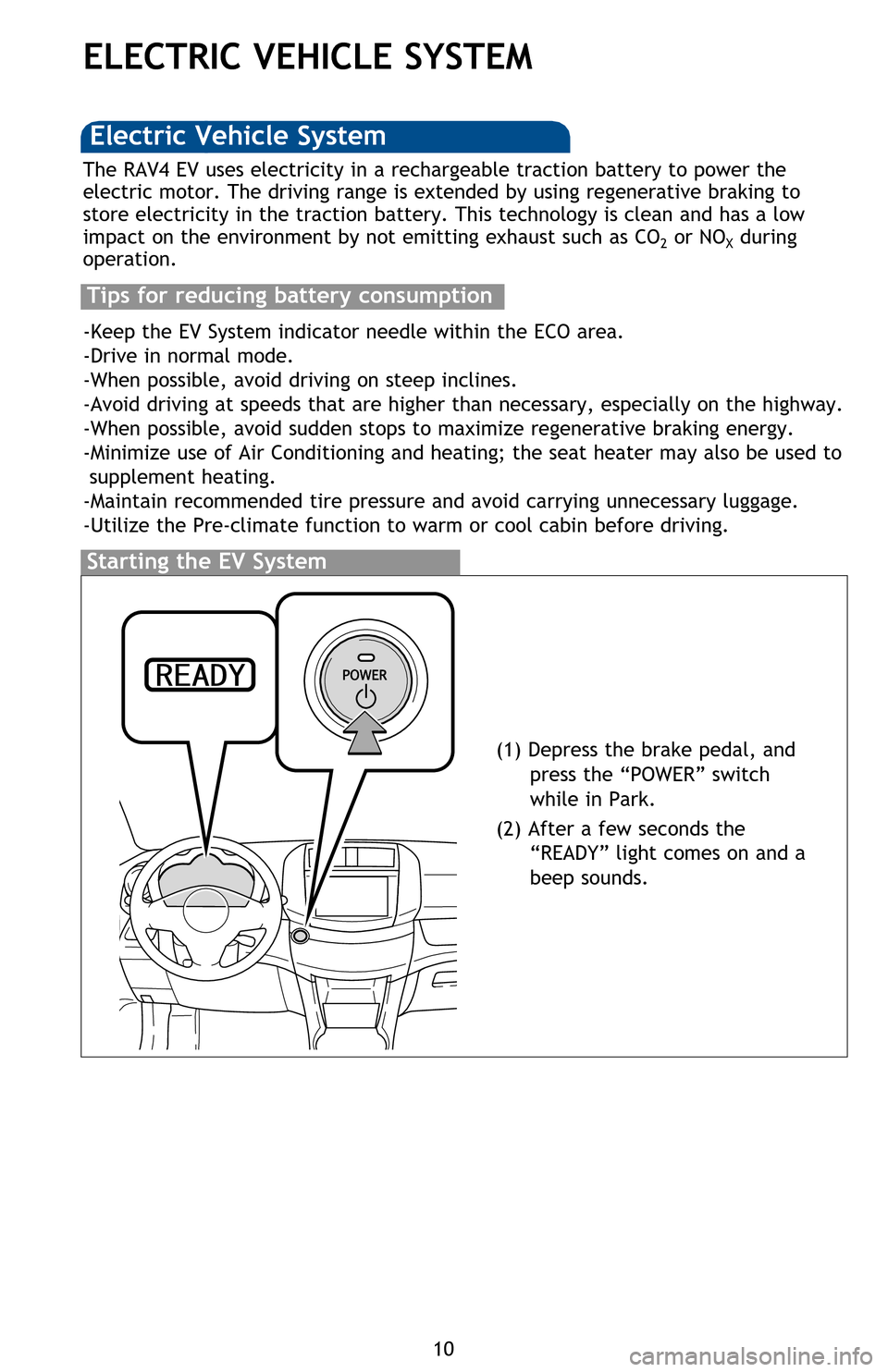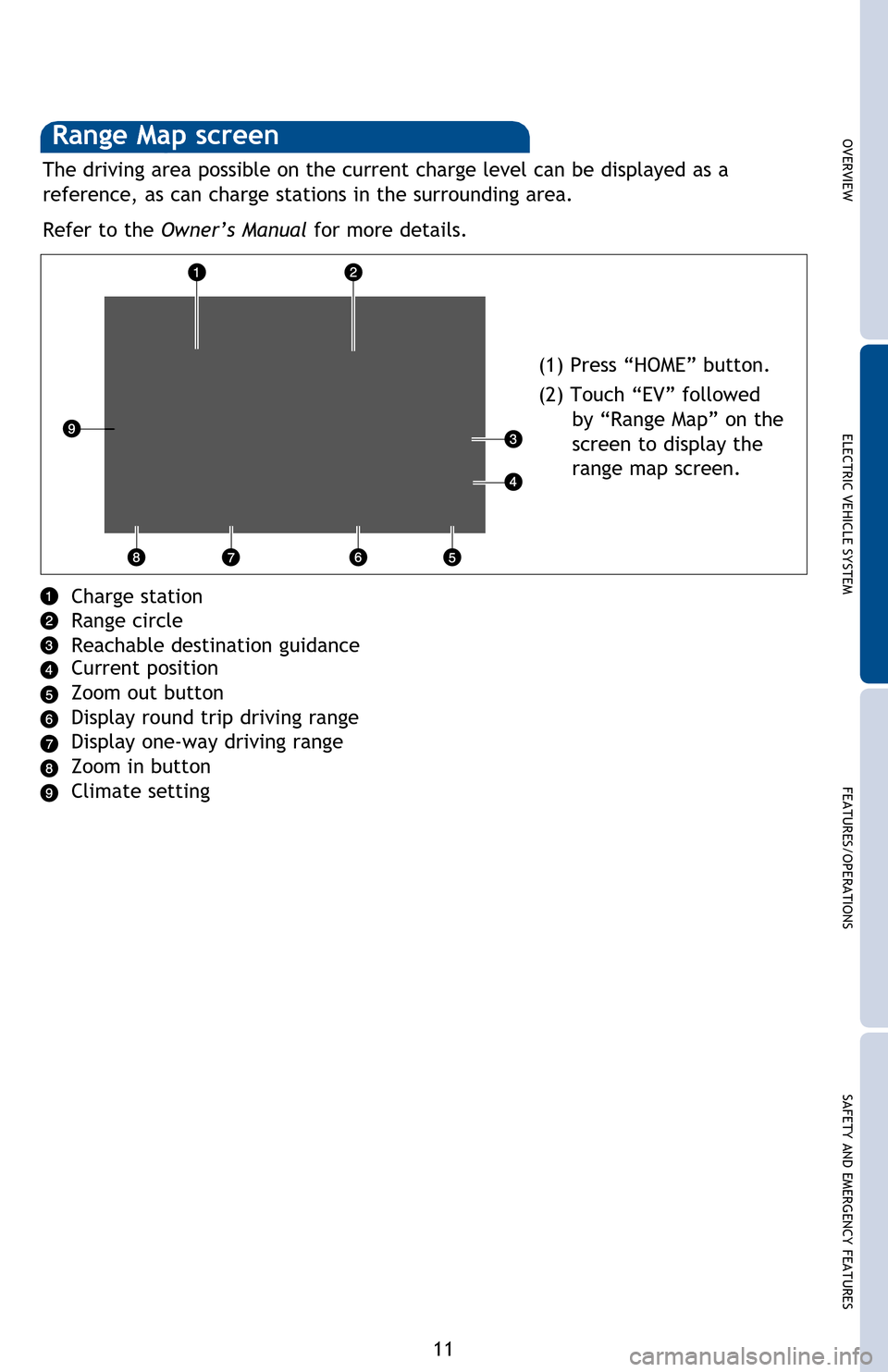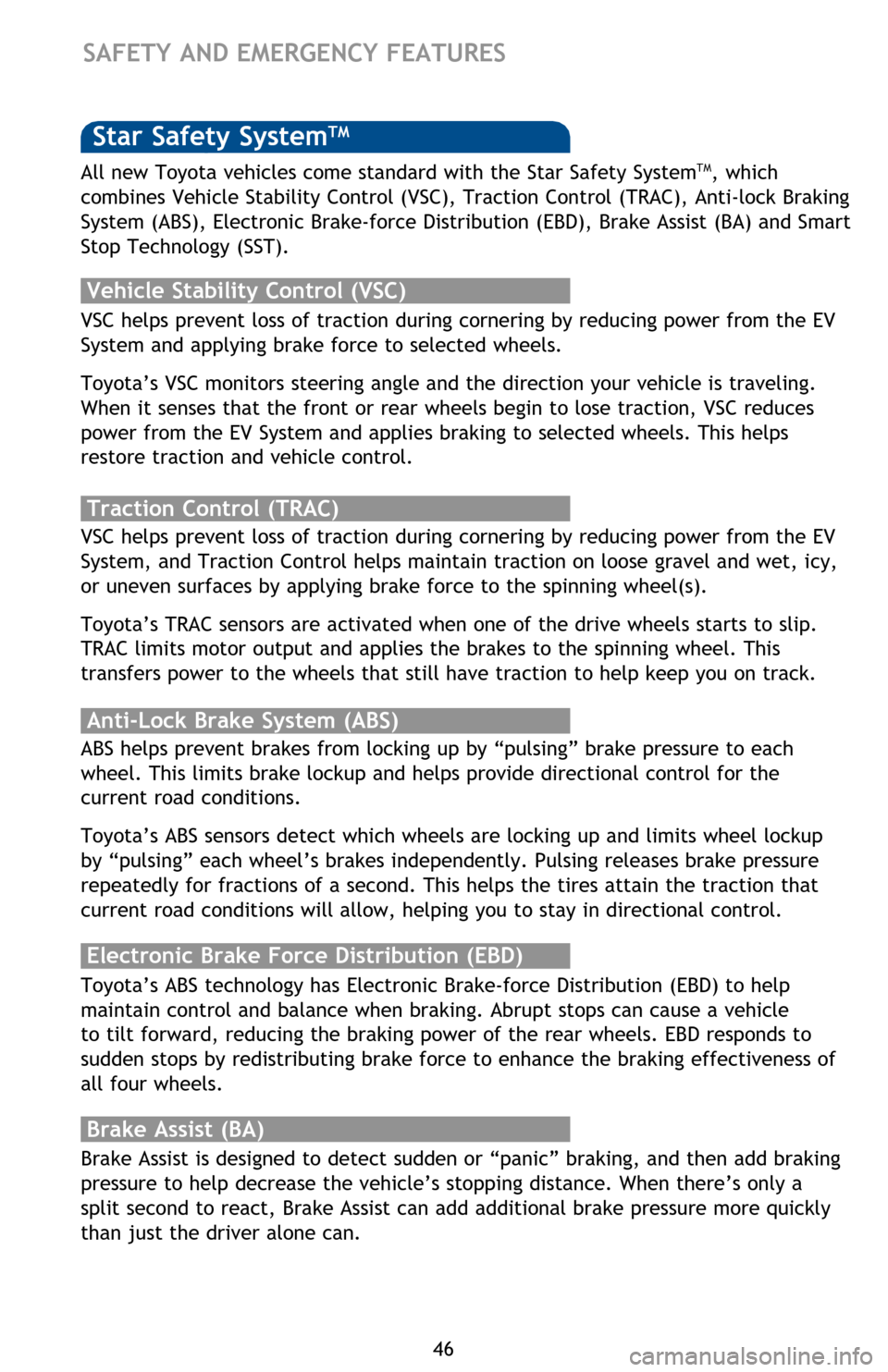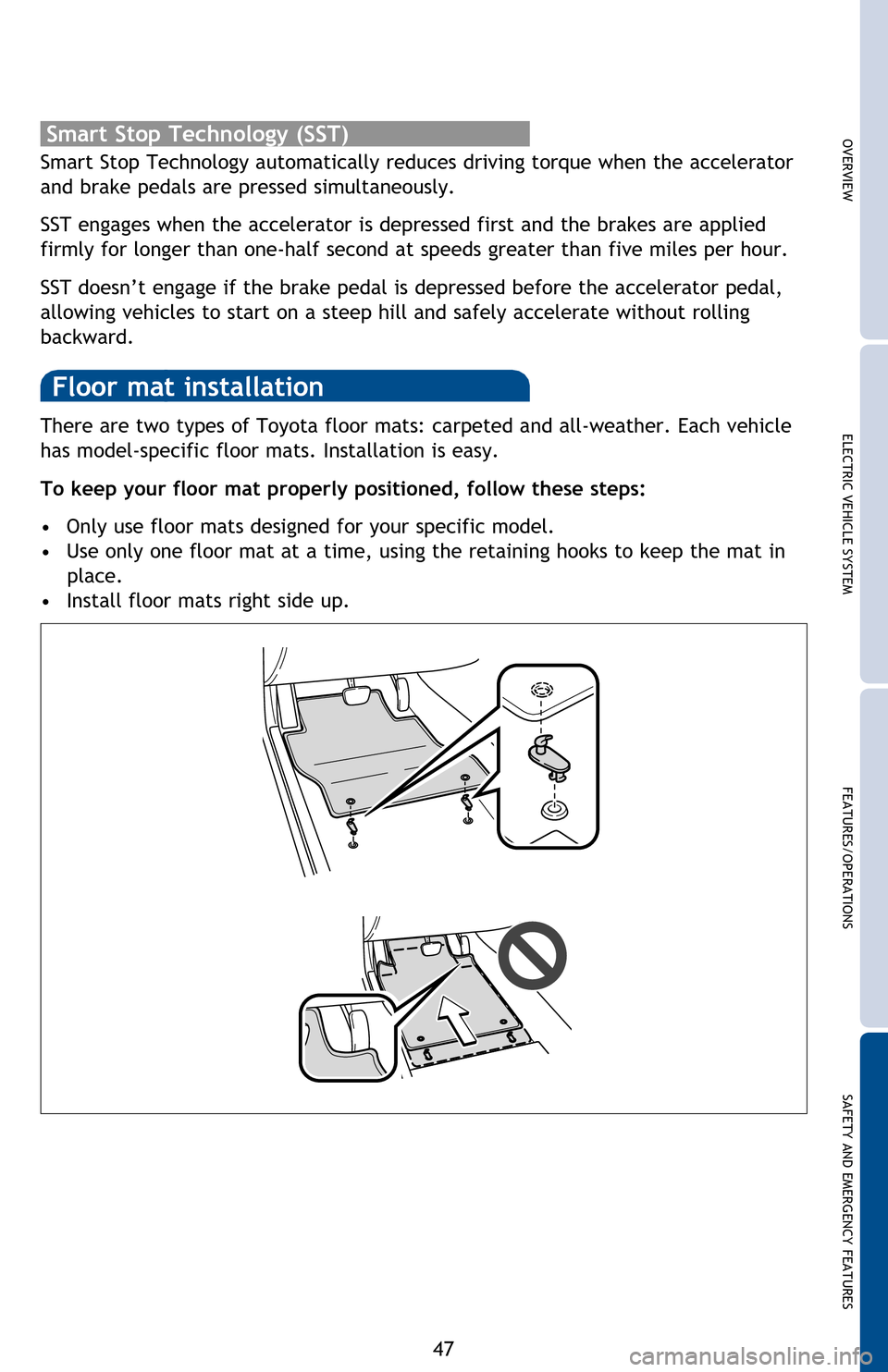ESP TOYOTA RAV4 EV 2013 1.G Quick Reference Guide
[x] Cancel search | Manufacturer: TOYOTA, Model Year: 2013, Model line: RAV4 EV, Model: TOYOTA RAV4 EV 2013 1.GPages: 52, PDF Size: 8.18 MB
Page 12 of 52

10
ELECTRIC VEHICLE SYSTEM
Starting the EV System
The RAV4 EV uses electricity in a rechargeable traction battery to power the
electric motor. The driving range is extended by using regenerative braking to
store electricity in the traction battery. This technology is clean and has a low
impact on the environment by not emitting exhaust such as CO
2 or NOX during
operation.
Tips for reducing battery consumption
-Keep the EV System indicator needle within the ECO area.
-Drive in normal mode.
-When possible, avoid driving on steep inclines.
-Avoid driving at speeds that are higher than necessary, especially on the highway.
-When possible, avoid sudden stops to maximize regenerative braking energy.
-Minimize use of Air Conditioning and heating; the seat heater may also be used to
supplement heating.
-Maintain recommended tire pressure and avoid carrying unnecessary luggage.
-Utilize the Pre-climate function to warm or cool cabin before driving.
Electric Vehicle SystemRange Map screen
The driving area possible on the current charge level can be displayed as a
reference, as can charge stations in the surrounding area.
Refer to the Owner’s Manual for more details.
(1) Depress the brake pedal, and
press the “POWER” switch
while in Park.
(2) After a few seconds the “READY” light comes on and a
beep sounds.
Charge station
Range circle
Reachable destination guidance
Current position
Zoom out button
Display round trip driving range
Display one-way driving range
Zoom in button
Climate setting
2013Rav4EV.indd 1012/3/12 11:37 PM
Page 13 of 52

OVERVIEWELECTRIC VEHICLE SYSTEM FEATURES/OPERATIONS
SAFETY AND EMERGENCY FEATURES
11
The RAV4 EV uses electricity in a rechargeable traction battery to power the
electric motor. The driving range is extended by using regenerative braking to
store electricity in the traction battery. This technology is clean and has a low
impact on the environment by not emitting exhaust such as CO
2 or NOX during
operation.
-Keep the EV System indicator needle within the ECO area.
-Drive in normal mode.
-When possible, avoid driving on steep inclines.
-Avoid driving at speeds that are higher than necessary, especially on the highway.
-When possible, avoid sudden stops to maximize regenerative braking energy.
-Minimize use of Air Conditioning and heating; the seat heater may also be used to
supplement heating.
-Maintain recommended tire pressure and avoid carrying unnecessary luggage.
-Utilize the Pre-climate function to warm or cool cabin before driving.
Range Map screen
The driving area possible on the current charge level can be displayed as a
reference, as can charge stations in the surrounding area.
Refer to the Owner’s Manual for more details.
(1) Depress the brake pedal, and
press the “POWER” switch
while in Park.
(2) After a few seconds the “READY” light comes on and a
beep sounds.
(1) Press “HOME” button.
(2) Touch “EV” followed by “Range Map” on the
screen to display the
range map screen.
Charge station
Range circle
Reachable destination guidance
Current position
Zoom out button
Display round trip driving range
Display one-way driving range
Zoom in button
Climate setting
2013Rav4EV.indd 1112/3/12 11:37 PM
Page 48 of 52

46
Star Safety SystemTM
VSC helps prevent loss of traction during cornering by reducing power from the EV
System and applying brake force to selected wheels.
Toyota’s VSC monitors steering angle and the direction your vehicle is traveling.
When it senses that the front or rear wheels begin to lose traction, VSC reduces
power from the EV System and applies braking to selected wheels. This helps
restore traction and vehicle control.
Vehicle Stability Control (VSC)
Anti-Lock Brake System (ABS)
ABS helps prevent brakes from locking up by “pulsing” brake pressure to each
wheel. This limits brake lockup and helps provide directional control for the
current road conditions.
Toyota’s ABS sensors detect which wheels are locking up and limits wheel lockup
by “pulsing” each wheel’s brakes independently. Pulsing releases brake pressure
repeatedly for fractions of a second. This helps the tires attain the traction that
current road conditions will allow, helping you to stay in directional control.
Brake Assist (BA)
Brake Assist is designed to detect sudden or “panic” braking, and then add braking
pressure to help decrease the vehicle’s stopping distance. When there’s only a
split second to react, Brake Assist can add additional brake pressure more quickly
than just the driver alone can. VSC helps prevent loss of traction during cornering by reducing power from the EV
System, and Traction Control helps maintain traction on loose gravel and wet, icy,
or uneven surfaces by applying brake force to the spinning wheel(s).
Toyota’s TRAC sensors are activated when one of the drive wheels starts to slip.
TRAC limits motor output and applies the brakes to the spinning wheel. This
transfers power to the wheels that still have traction to help keep you on track.
Traction Control (TRAC)
Electronic Brake Force Distribution (EBD)
Toyota’s ABS technology has Electronic Brake-force Distribution (EBD) to help
maintain control and balance when braking. Abrupt stops can cause a vehicle
to tilt forward, reducing the braking power of the rear wheels. EBD responds to
sudden stops by redistributing brake force to enhance the braking effectiveness of
all four wheels.
There are two types of Toyota floor mats: carpeted and all-weather. Each vehicle
has model-specific floor mats. Installation is easy.
To keep your floor mat properly positioned, follow these steps:
• Only use floor mats designed for your specific model.
• Use only one floor mat at a time, using the retaining hooks to keep the mat in
place.
• Install floor mats right side up.
Floor mat installation
SAFETY AND EMERGENCY FEATURES
All new Toyota vehicles come standard with the Star Safety SystemTM, which
combines Vehicle Stability Control (VSC), Traction Control (TRAC), Anti-lock Braking
System (ABS), Electronic Brake-force Distribution (EBD), Brake Assist (BA) and Smart
Stop Technology (SST).Smart Stop Technology automatically reduces driving torque when the accelerator
and brake pedals are pressed simultaneously.
SST engages when the accelerator is depressed first and the brakes are applied
firmly for longer than one-half second at speeds greater than five miles per hour.
SST doesn’t engage if the brake pedal is depressed before the accelerator pedal,
allowing vehicles to start on a steep hill and safely accelerate without rolling
backward.
Smart Stop Technology (SST)
2013Rav4EV.indd 4612/3/12 11:40 PM
Page 49 of 52

OVERVIEWELECTRIC VEHICLE SYSTEM FEATURES/OPERATIONS
SAFETY AND EMERGENCY FEATURES
47
VSC helps prevent loss of traction during cornering by reducing power from the EV
System and applying brake force to selected wheels.
Toyota’s VSC monitors steering angle and the direction your vehicle is traveling.
When it senses that the front or rear wheels begin to lose traction, VSC reduces
power from the EV System and applies braking to selected wheels. This helps
restore traction and vehicle control.
ABS helps prevent brakes from locking up by “pulsing” brake pressure to each
wheel. This limits brake lockup and helps provide directional control for the
current road conditions.
Toyota’s ABS sensors detect which wheels are locking up and limits wheel lockup
by “pulsing” each wheel’s brakes independently. Pulsing releases brake pressure
repeatedly for fractions of a second. This helps the tires attain the traction that
current road conditions will allow, helping you to stay in directional control.
Brake Assist is designed to detect sudden or “panic” braking, and then add braking
pressure to help decrease the vehicle’s stopping distance. When there’s only a
split second to react, Brake Assist can add additional brake pressure more quickly
than just the driver alone can. VSC helps prevent loss of traction during cornering by reducing power from the EV
System, and Traction Control helps maintain traction on loose gravel and wet, icy,
or uneven surfaces by applying brake force to the spinning wheel(s).
Toyota’s TRAC sensors are activated when one of the drive wheels starts to slip.
TRAC limits motor output and applies the brakes to the spinning wheel. This
transfers power to the wheels that still have traction to help keep you on track.
Toyota’s ABS technology has Electronic Brake-force Distribution (EBD) to help
maintain control and balance when braking. Abrupt stops can cause a vehicle
to tilt forward, reducing the braking power of the rear wheels. EBD responds to
sudden stops by redistributing brake force to enhance the braking effectiveness of
all four wheels.
There are two types of Toyota floor mats: carpeted and all-weather. Each vehicle
has model-specific floor mats. Installation is easy.
To keep your floor mat properly positioned, follow these steps:
• Only
use floor mats designed for your specific model.
• Use
only one floor mat at a time, using the retaining hooks to keep the mat in
place.
•
Install
floor mats right side up.
Floor mat installation
SAFETY AND EMERGENCY FEATURES
All new Toyota vehicles come standard with the Star Safety SystemTM, which
combines Vehicle Stability Control (VSC), Traction Control (TRAC), Anti-lock Braking
System (ABS), Electronic Brake-force Distribution (EBD), Brake Assist (BA) and Smart
Stop Technology (SST).Smart Stop Technology automatically reduces driving torque when the accelerator
and brake pedals are pressed simultaneously.
SST engages when the accelerator is depressed first and the brakes are applied
firmly for longer than one-half second at speeds greater than five miles per hour.
SST doesn’t engage if the brake pedal is depressed before the accelerator pedal,
allowing vehicles to start on a steep hill and safely accelerate without rolling
backward.
Smart Stop Technology (SST)
2013Rav4EV.indd 4712/3/12 11:41 PM